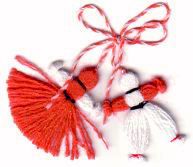
Back Мартеница Bulgarian Proslava 1. marta BS Martenitsa Catalan Martenica Czech Martenitsa Danish Martenitsa DAG Marteniza German Martenitsa DGA Μάρτης (έθιμο) Greek Martenitsa FAT

A Martenitsa (Bulgarian: мартеница, pronounced [ˈmartɛnit͡sa]; Macedonian: мартинка, romanized: martinka; Greek: μάρτης, romanized: mártis; Romanian: mărțișor; Albanian: verore) is a small piece of adornment, made of white and red yarn and usually in the form of two dolls, a white male and a red female. Martenitsi are worn from Baba Marta Day (March 1) until the wearer first sees a stork, swallow, or blossoming tree (or until the end of March (April 1)). The name of the holiday means "Grandma March" in Bulgarian and Macedonian, the holiday and the wearing of Martenitsi are a Bulgarian and Macedonian tradition related to welcoming the spring, which according to Bulgarian and Macedonian folklore begins in March.[1]
In Albania, it is worn on the March 14 (the old first day of March in the Julian calendar) to celebrate the Summer Fest (Dita e Verës). In Albania, the Summer Fest is dedicated to the ancient Goddess Diana.
Inscribed on the UNESCO Representative List of the Intangible Cultural Heritage of Humanity. [2][3][4]
- ^ Grandmother March, 1st March, Martenitsa Archived 2015-04-02 at the Wayback Machine Bulgarian rituals and traditions Regional Museum Burgas
- ^ "Cultural practices associated to the 1st of March - intangible heritage - Culture Sector - UNESCO". Ich.unesco.org. Archived from the original on 2020-12-10. Retrieved 2019-12-21.
- ^ Dubravka Ugresic (11 January 2011). Baba Yaga Laid an Egg. Grove Atlantic. p. 244. ISBN 9780802197634. Archived from the original on 18 April 2023. Retrieved 19 March 2023.
- ^ Canadian Ethnic Studies. Research centre for Canadian Ethnic Studies at the University of Calgary for the Canadian Ethnic Studies Association. 1975. p. 44. Archived from the original on 2023-04-18. Retrieved 2023-03-19.
© MMXXIII Rich X Search. We shall prevail. All rights reserved. Rich X Search